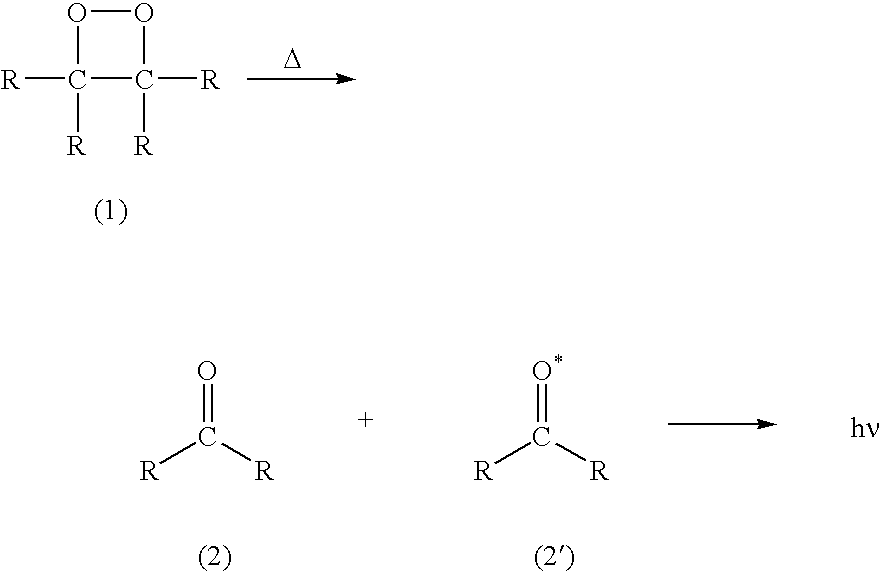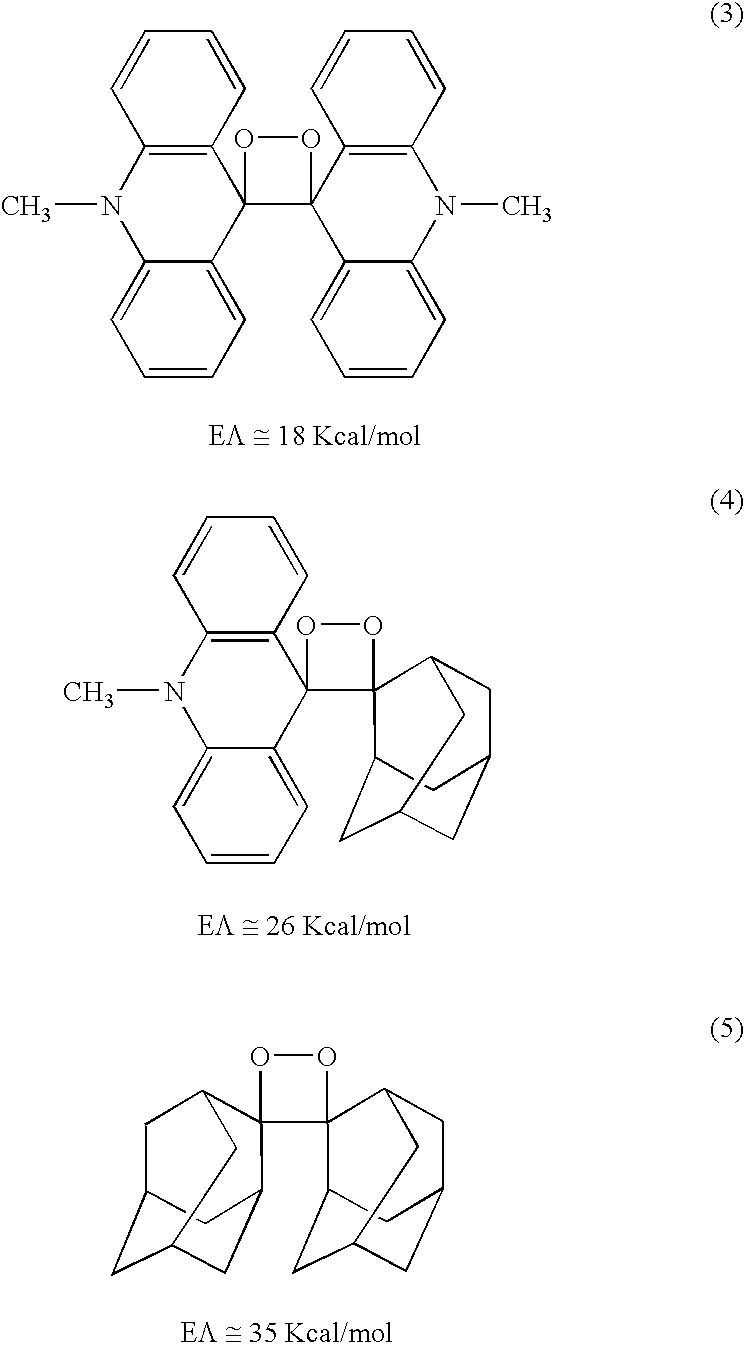Chemiluminescent 1,2-dioxetanes
a technology of dioxetanes and chemiluminescent compounds, applied in the field of chemiluminescent compounds, can solve the problems of poor luminosity of these molecules, and achieve the effect of convenient trigger and easy handling
- Summary
- Abstract
- Description
- Claims
- Application Information
AI Technical Summary
Benefits of technology
Problems solved by technology
Method used
Image
Examples
example i
[0072]This example illustrates the preparation of [(4-Methoxy)-4-(3-phosphoryloxyphenyl)] spiro [1,2-dioxetane-3,13′-(8-n-propyl) tricyclo [7.3.1,o2,7] tridec-2,7-ene], disodium salt (32) in accordance with the present invention. The sequence of the reactions can be shown as:[0073](a) Synthesis of 8-n-propyl-2-hydroxytricyclo[7.3.1.02,7]tridecan-13-one (24).
[0074]Into a three-neck 500 mL round bottom flask equipped with magnetic stirrer and an oil bath under nitrogen was added 250 parts of cyclohexanone. The oil bath temperature was maintained at 70-75° C. with stirring. A solution of 2.5 parts of potassium hydroxide dissolved in 25 mL of absolute ethyl alcohol was added to the reaction flask in one portion. Thirty parts of butyraldehyde was dissolved in 35 mL of absolute ethyl alcohol and added dropwise to the reaction flask over a period of 6 hours. The reaction mixture was stirred at 70-75° C. for the 15 hours. After the reaction mixture was cooled to room temperature and refrige...
example ii
This example illustrates the preparation of [(4-Methoxy)-4-(3-phosphoryloxyphenyl)] spiro [1,2-dioxetane-3,13′-tricyclo [7.3.1,o2,7]tridec-2,7-ene], disodium salt (39).This dioxetane was prepared by the sequence of the reactions in accordance herewith:
[0097](a) Synthesis of 2-Hydroxytricyclo[7.3.1.02,7]tridecane-13-one (34).
[0098]Into a 500 mL three-neck round bottom flask equipped with magnetic stirrer and oil bath was added 250 parts of cyclohexanone (22) under nitrogen. The oil bath temperature was maintained at 80-85° C. with stirring. Sixty mL of absolute ethanol with 2.5 parts of potassium hydroxide was added in one portion. Sixteen parts of paraformaldehyde was added in small portions over a period of 3 hours and the temperature was maintained for 15 hours with stirring. The reaction mixture was cooled to room temperature and refrigerated at 4° C. for 15 hours. The inside surface of the flask and liquid was scratched with a glass rod. The solid started to separate and the fla...
example iii
This example illustrates the preparation of [(4-methoxy)-4-(3-phosphoryloxyphenyl] spiro [1,2-dioxetane-3,2′-adamantan-4,5-ene], disodium salt (46). The sequence of the reactions in accordance herewith:
[0115](a) Synthesis of 5-Hydroxyadamantan-2-one (40).
[0116]Into a single neck 500 mL round bottom flask equipped with a magnetic stirrer and water bath, 75 parts of acetic acid containing 5 parts acetic anhydride was added. Twenty five parts of chromium trioxide was added in portions in 40 minutes while the temperature was maintained at 15-20° C. with water bath. Five parts of Adamantan-2-one was added in portions over a period of 15 minutes. Stirring was continued for one hour. The viscous reaction mixture was poured into cold 250 mL of aqueous 20% sodium hydroxide solution. The aqueous layer was extracted with 3×250 mL of ethyl acetate and washed with 2×250 mL of water and dried over sodium sulfate. Solvent was evaporated under reduced pressure and chromatographed on silica gel colu...
PUM
 Login to View More
Login to View More Abstract
Description
Claims
Application Information
 Login to View More
Login to View More - R&D
- Intellectual Property
- Life Sciences
- Materials
- Tech Scout
- Unparalleled Data Quality
- Higher Quality Content
- 60% Fewer Hallucinations
Browse by: Latest US Patents, China's latest patents, Technical Efficacy Thesaurus, Application Domain, Technology Topic, Popular Technical Reports.
© 2025 PatSnap. All rights reserved.Legal|Privacy policy|Modern Slavery Act Transparency Statement|Sitemap|About US| Contact US: help@patsnap.com



